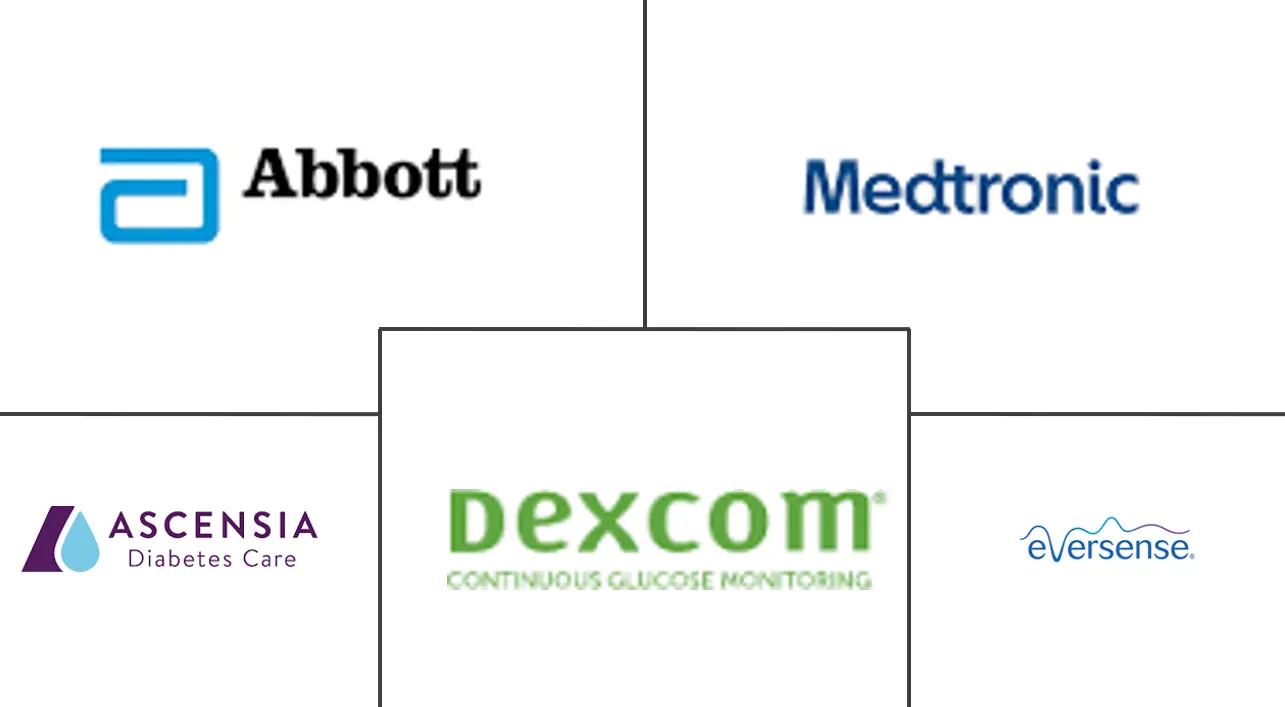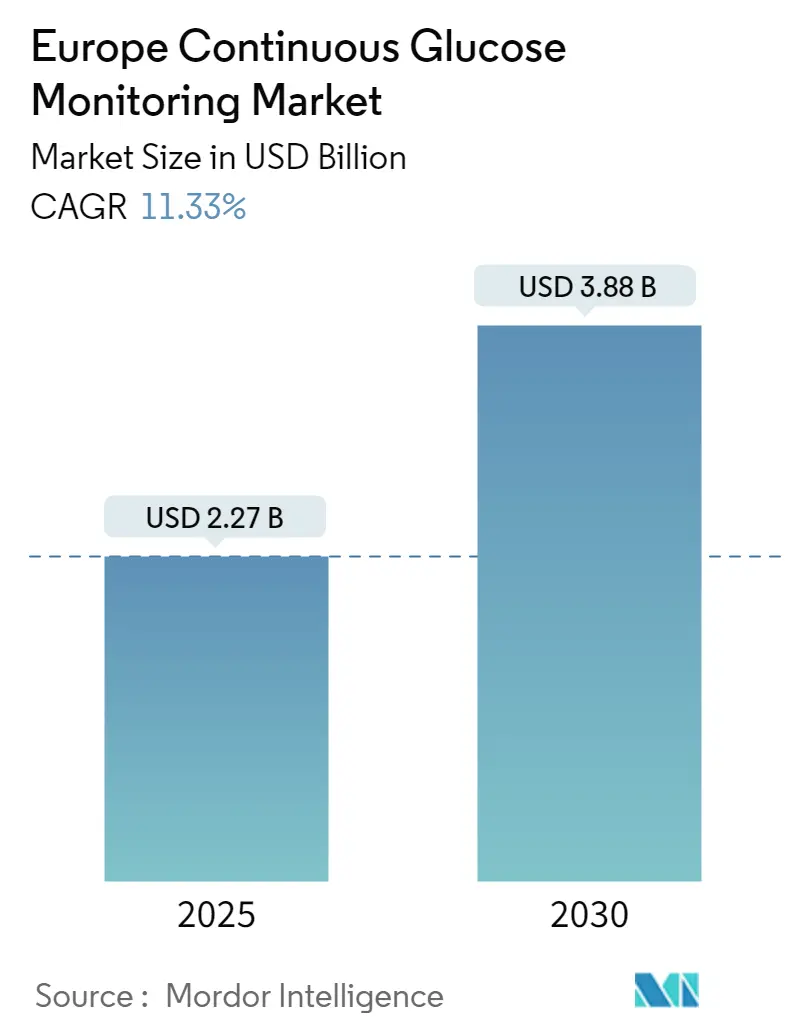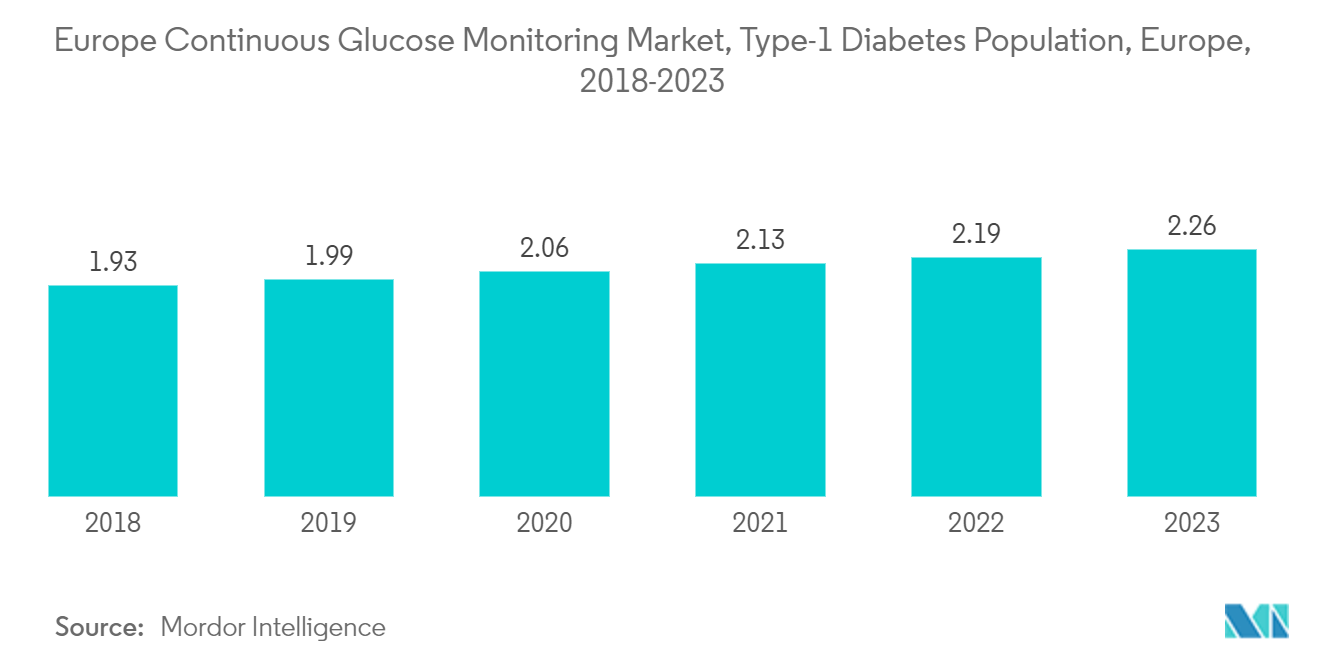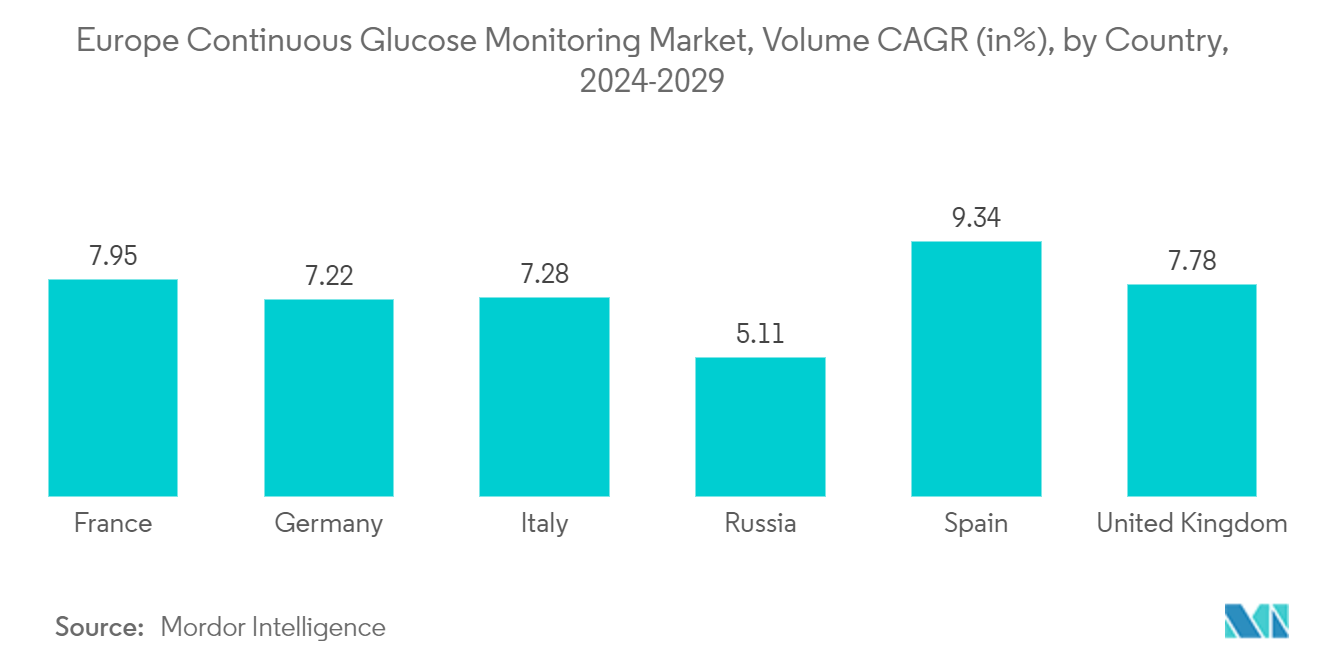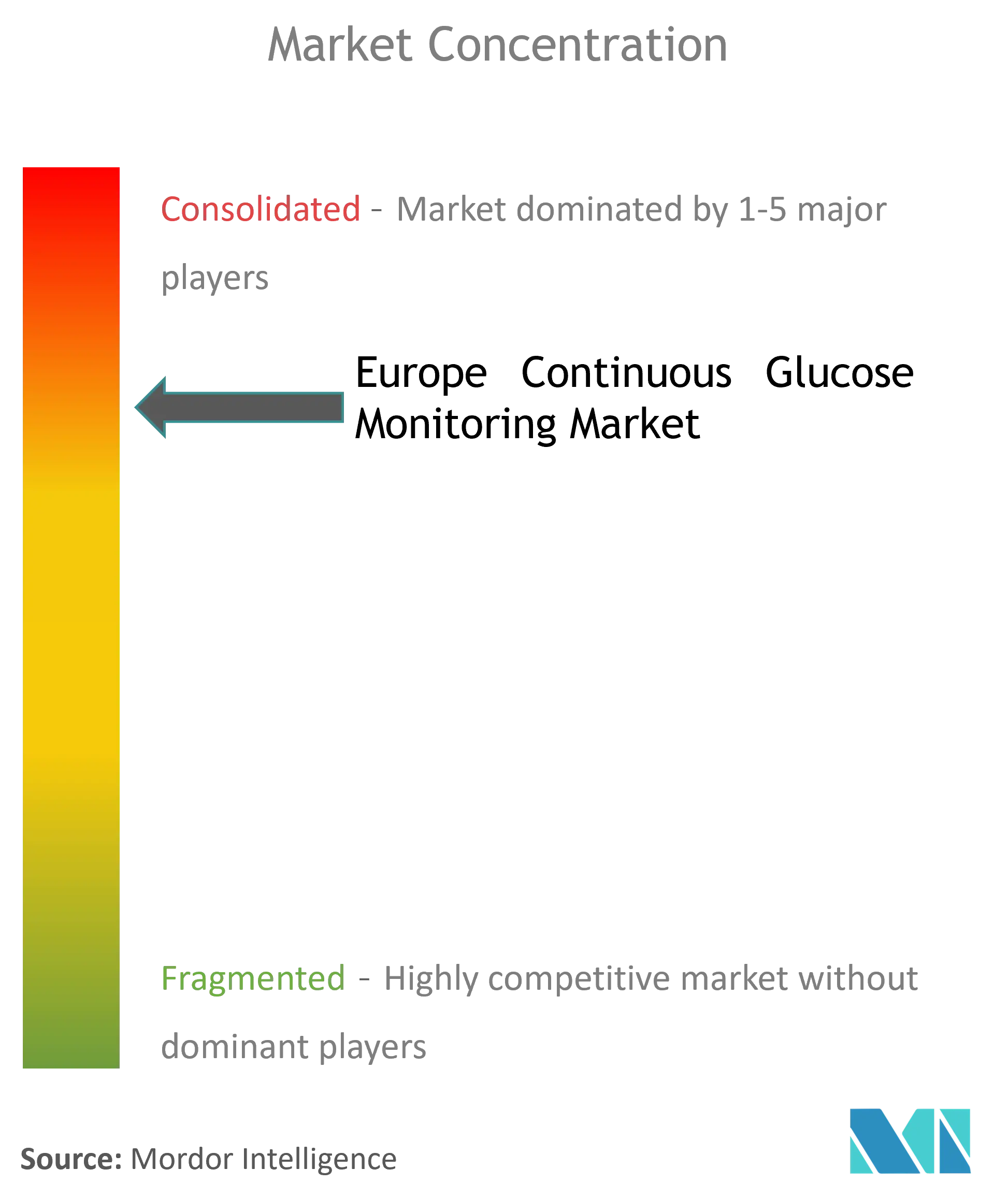Europe Continuous Glucose Monitoring Market Analysis
The Europe Continuous Glucose Monitoring Market size is estimated at USD 2.27 billion in 2025, and is expected to reach USD 3.88 billion by 2030, at a CAGR of 11.33% during the forecast period (2025-2030).
In recent times, Europe has observed a significant rise in its diabetes population, a trend that mirrors global patterns. The prevalence of diabetes in Europe has been steadily increasing due to factors such as an aging population, changes in lifestyle habits, and genetic predispositions. This rise encompasses both type 1 and type 2 diabetes, leading to a greater demand for advanced technologies to effectively manage the condition.
A noteworthy development in diabetes management in Europe is the growing adoption of continuous glucose monitoring (CGM) devices. These devices offer a groundbreaking approach to monitoring blood glucose levels by providing real-time and continuous data. By eliminating the need for frequent fingerstick tests, CGM devices not only simplify the process but also provide individuals with valuable insights into their glucose patterns throughout the day and night.
The surge in CGM device usage across Europe can be attributed to various factors. Firstly, advancements in CGM technology have made these devices more accurate, reliable, and user-friendly, making them more appealing to individuals with diabetes. Additionally, increased awareness among healthcare professionals and patients about the benefits of CGM, such as improved glycemic control, reduced risk of hypoglycemia, and enhanced quality of life, has contributed to their widespread adoption.
Moreover, the European healthcare landscape, which emphasizes universal healthcare coverage and access to innovative medical technologies, has created a favorable environment for the expansion of the CGM market. Reimbursement policies in several European countries now include coverage for CGM devices for eligible patients, making them more accessible to a wider population.
In general, the rising number of diabetes cases in Europe, along with the increasing awareness of the advantages of continuous glucose monitoring, has led to a higher demand for CGM devices throughout the continent. This pattern is anticipated to persist in the future, stimulating more advancements in CGM technology and enhancing diabetes care results for people in Europe.
Europe Continuous Glucose Monitoring Market Trends
Continuous Glucose Monitoring Devices Prove to be an Instrumental Tool in maintaining Glycemic Balance
CGMs are used to deliver a more descriptive picture of blood glucose patterns and trends than can be achieved by traditional routine checking of glucose levels at set intervals. The current CGM devices can either retrospectively display the trends in the levels of blood glucose by downloading the data or give a real-time picture of glucose levels through receiver displays.
Most real-time CGMs can offer an alert to patients, parents, or caregivers during actual or pending glycemic visits to facilitate timely management of blood glucose. This factor, along with the fact that CGM devices are becoming cheaper with the advent of new technologies like cell phone integration, means the CGM market is expected to witness steady growth during the forecast period.
European countries are suffering from the burden of high diabetes expenditures. According to the IDF, the overall diabetes expenditure in Europe among the population aged 20-79 years was USD 156 billion, and it is expected to increase to USD 174 billion by 2040. According to other statistics from the IDF, every year 21,600 children are added to the type-1 diabetic population pool.
These figures indicate that approximately 9% of the total healthcare expenditure is spent on diabetes in Europe. For patients relying on insulin pumps or multiple daily injections (MDI) therapy, the CGMs prove to be an effective tool that helps in the improvement of glycemic balance without aggregating the danger of severe hypoglycemia.
Germany is Expected to Dominate the Europe Continuous Glucose Monitoring Devices Market.
In the European continuous glucose monitoring market, Germany accounted for approximately 21% of the market value in the current year. Germany has one of the highest diabetes populations in the European region, with more than 9 million diabetes cases in the present year. By forecasting years, the continuous glucose monitoring market in Europe is expected to be valued at more than USD 2.8 billion.
The German Center for Diabetes Research (DZD) conducts extensive scientific research to develop effective prevention and treatment measures to halt the emergence or progression of diabetes. The CGM devices must be used alongside insulin pumps. It is observed that there may be a potential increase in the diabetes population, which can be directly related to a higher number of diabetic patients using insulin pumps for diabetes management. Thus, the number of units of CGM devices sold is also expected to rise.
Comparing a routine examination of blood glucose levels at predetermined intervals to the current CGM devices reveals a detailed picture of blood glucose patterns and trends. Also, modern continuous glucose monitoring devices can either provide a real-time image of glucose levels through receiver displays or retrospectively exhibit trends in blood glucose levels by downloading the data. Patients with type-1 diabetes use CGM much less frequently than those with type-2 diabetes. Yet, type-1 diabetes patients spend almost twice as much on these devices as type-2 diabetic patients do. The Abbott Freestyle Libre and the Dexcom G6 are the two most recent CGM devices, and they surmounted several technical challenges.
Throughout the coming years, it is anticipated that the prevalence of type-2 diabetes will rise significantly as a result of an aging population and an unhealthy lifestyle. The most important elements in preventing complications in German type-2 diabetes patients are high-quality care, which includes proper monitoring, control of risk factors, and active self-management. The development of novel medications to give diabetic patients more treatment options has been driven by the disease's increasing incidence, prevalence, and progressive nature.
Therefore, owing to the aforesaid factors, the growth of the studied market is anticipated in the European region.
Europe Continuous Glucose Monitoring Industry Overview
CGM manufacturers who are concurrent with strategy-based M&A operations hold a sizable portion of the European continuous glucose monitoring devices market study, and these manufacturers are constantly entering new markets to generate new revenue streams and boost existing ones. The market studied is consolidated, with Dexcom, Abbott, and Medtronic holding a high market share, followed by regional manufacturers accounting for a relatively smaller share.
Europe Continuous Glucose Monitoring Market Leaders
-
Dexcom
-
Medtronic
-
Abbott
-
Senseonics
-
Ascensia
- *Disclaimer: Major Players sorted in no particular order
Europe Continuous Glucose Monitoring Market News
- October 2023: Medtronic has recently introduced Simplera, a cutting-edge CGM designed for individuals with diabetes aged 2 and above. Currently undergoing FDA evaluation for clearance in the United States, Simplera boasts a modern, disposable design and eliminates the need for fingersticks.
- June 2022: Ascensia Diabetes Care, maker of the Contour blood glucose monitoring (BGM) system portfolio and distributor of Eversense Continuous Glucose Monitoring (CGM) Systems, announces that its partner Senseonics Holdings, Inc., received CE Mark approval for the Eversense E3 Continuous Glucose Monitoring (CGM) System, clearing the way for its use in European Union (EU) member countries.
Europe Continuous Glucose Monitoring Industry Segmentation
Continuous glucose monitoring devices use glucose oxidase to measure blood sugar levels. In the sensor, platinum combines with glucose oxidase to produce hydrogen peroxidase, which then produces an electrical signal that is sent to the transmitter. Europe's continuous glucose monitoring market is segmented by components and geography. The report offers the value (in USD) and volume (in units) for the above segments.
| Continuous Glucose Monitoring | Sensors |
| Durables | |
| Geography | France |
| Germany | |
| Italy | |
| Spain | |
| Russia | |
| United Kingdom | |
| Rest of Europe |
Europe Continuous Glucose Monitoring Market Research FAQs
How big is the Europe Continuous Glucose Monitoring Market?
The Europe Continuous Glucose Monitoring Market size is expected to reach USD 2.27 billion in 2025 and grow at a CAGR of 11.33% to reach USD 3.88 billion by 2030.
What is the current Europe Continuous Glucose Monitoring Market size?
In 2025, the Europe Continuous Glucose Monitoring Market size is expected to reach USD 2.27 billion.
Who are the key players in Europe Continuous Glucose Monitoring Market?
Dexcom, Medtronic, Abbott, Senseonics and Ascensia are the major companies operating in the Europe Continuous Glucose Monitoring Market.
What years does this Europe Continuous Glucose Monitoring Market cover, and what was the market size in 2024?
In 2024, the Europe Continuous Glucose Monitoring Market size was estimated at USD 2.01 billion. The report covers the Europe Continuous Glucose Monitoring Market historical market size for years: 2019, 2020, 2021, 2022, 2023 and 2024. The report also forecasts the Europe Continuous Glucose Monitoring Market size for years: 2025, 2026, 2027, 2028, 2029 and 2030.
Our Best Selling Reports
Europe Continuous Glucose Monitoring Industry Report
The Report Covers Continuous Glucose Monitoring Companies and It is Segmented by Components (sensors and Durables) and Geography (France, Germany, Italy, Spain, Russia, The United Kingdom, And the Rest of Europe). The Market Values are Provided (in USD) and Volume (in Units) for the Above Segments. Statistics for the Europe Continuous Glucose Monitoring market share, size and revenue growth rate, created by Mordor Intelligence™ Industry Reports. Europe Continuous Glucose Monitoring analysis includes a market forecast outlook and historical overview. Get a sample of this industry analysis as a free report PDF download.
The market size and market share of continuous glucose monitoring in Europe is comprehensively covered in the report. This industry analysis provides valuable insights into the market trends and market growth. The market analysis includes detailed information on market segmentation by components and geography, providing a clear market overview.
Industry reports and industry research indicate significant growth in the market value of continuous glucose monitoring systems. The market forecast highlights the expected market growth and market predictions for the coming years. The report also discusses the market leaders in the industry, offering a thorough market review and market outlook.
Industry information and industry statistics are crucial for understanding the current market dynamics. The report example and report PDF provide a detailed industry overview and industry outlook. Industry trends and industry sales are analyzed to give a comprehensive view of the market.
Research companies have contributed to the detailed market data and industry size analysis. The market forecast and market outlook are essential for stakeholders to make informed decisions. The report also includes a historical overview and market segmentation to provide a complete picture of the market.

